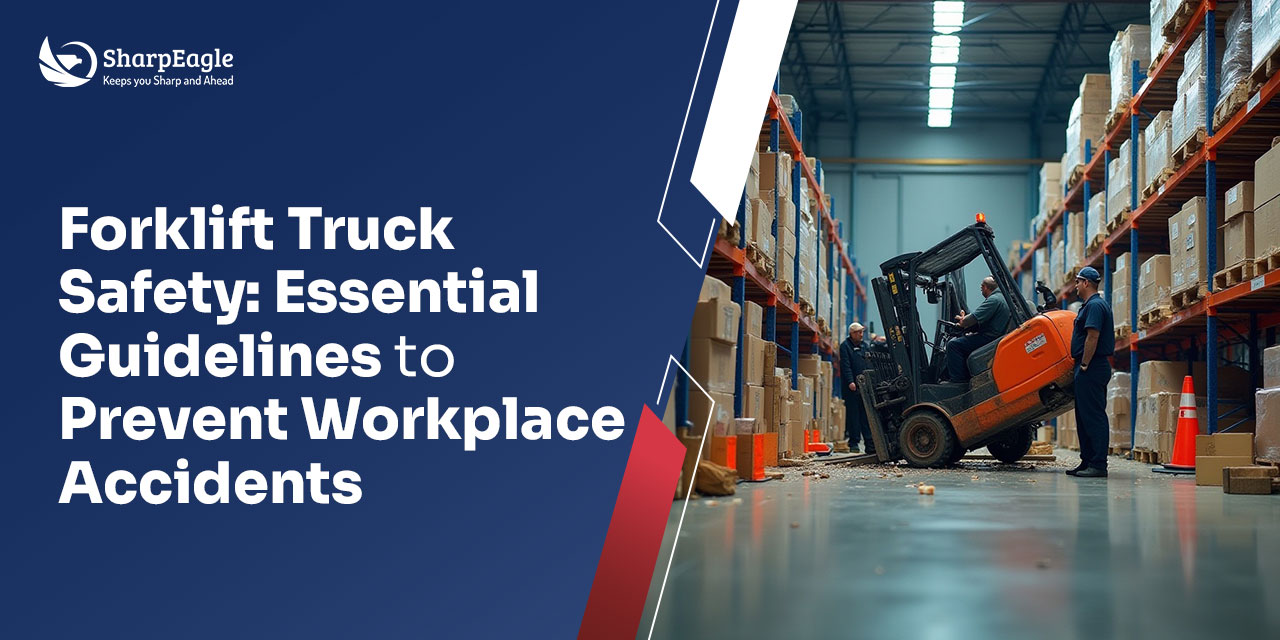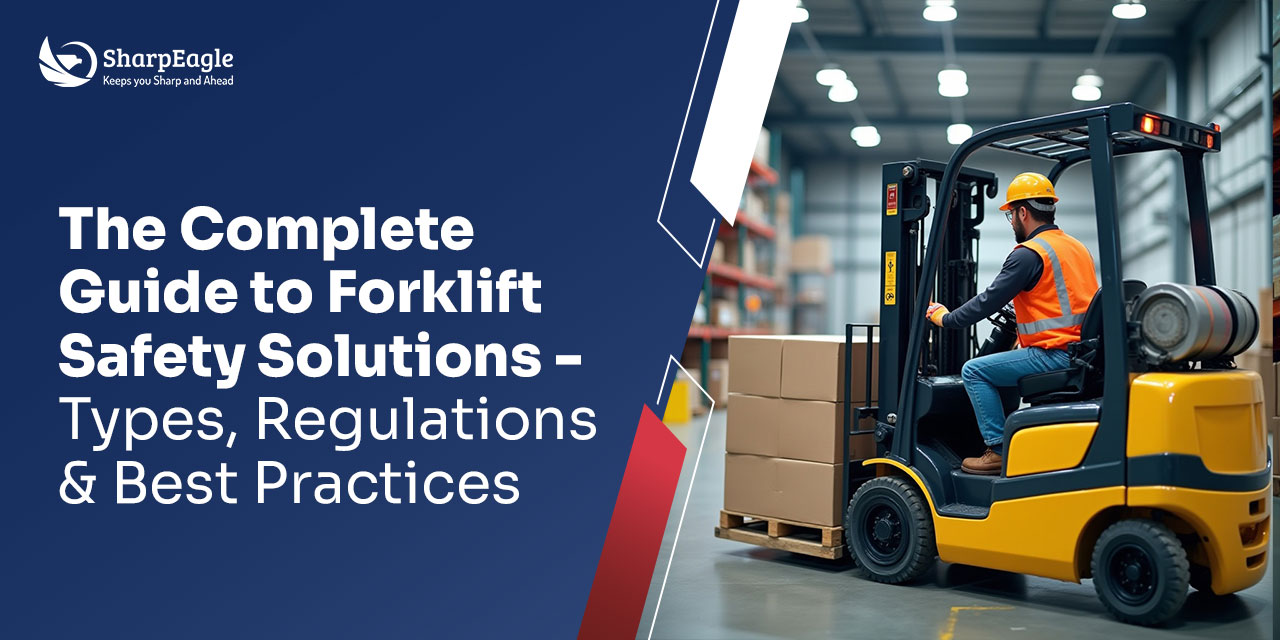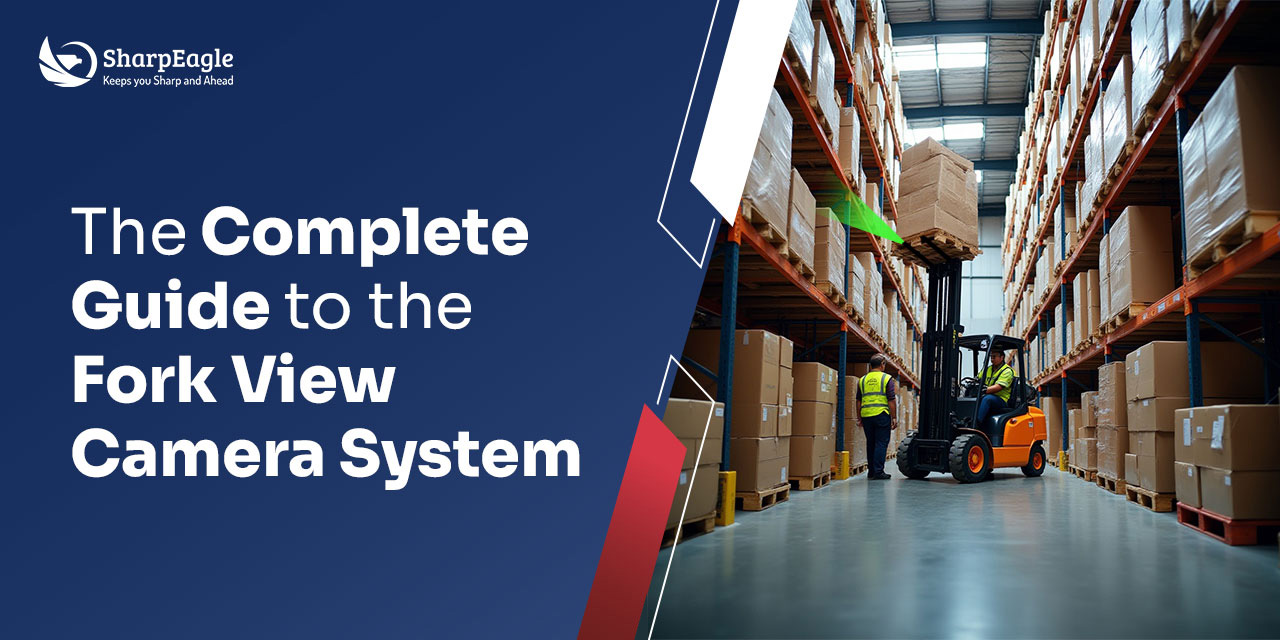

A forklift is the most dangerous workplace transport. The reason behind it is the inherent blind spots of forklifts. Limited visual access to the operators often leads to fatal workplace accidents.
Yet, forklifts cannot be replaced since there is no alternate mode of goods transportation in a warehouse. However, these vehicles can be made safer for daily operations using forklift cameras that specifically tackle blind spots and minimize the risk of accidents.
Forklift cameras not only improve visibility but also improve ergonomics for operators. Instead of a manual inspection, operators can rely on these cameras for assessing the surroundings, thus reducing the strain for the forklift operator. Lesser fatigue further improves the workplace productivity of the crew.
Let’s understand the benefits of forklift camera systems in detail.

Blind spots pose challenges for operators in detecting obstructions and pedestrians. Typically, operators rely on safety lights or horns to alert pedestrians of their approach. However, unforeseen obstructions can still lead to accidents, damaging the forklift and inventory. Implementing additional visual aids or sensors can help mitigate these risks by enhancing operators' awareness of their surroundings, improving overall safety, and reducing potential damages.
When you install a wireless forklift camera, operators can see those obstructions on a monitor inside the cabin. So, forklift safety cameras reduce blind spots and help operators manoeuvre more efficiently. This reduces accidents and ensures safety in your warehouse.

You can easily incorporate forklift cameras into other safety systems and enhance workplace safety. You can easily combine your forklift camera system with auto-braking mechanisms, mobile CCTV systems, and vehicle radar. This will give the truck operator a complete vision of the top, bottom, right, and left blind spots, together with a complete vision of the fork. This way, all blind spots around the forklift can be accounted for and effectively eliminated.
Due to limited visibility, forklift operators face challenges in accurately placing loads. As previously mentioned, forklift cameras play a pivotal role in enhancing visibility and safety. They offer a real-time view of the warehouse environment, aiding operators in assessing load capacity, distribution, and centre accurately. This allows operators to place goods precisely, ensuring their stability, proper balancing, and correct positioning. By preventing overloading and maintaining load limits, these technologies help complete tasks correctly the first time without any accidents or casualties, improving operational efficiency.
Forklift cameras allow operators to reduce errors in forklift operations because they can see better and make judgments with improved concentration, accuracy, and speed. This means they can complete tasks faster, leading to increased productivity in the warehouse. Moreover, forklift cameras reduce accidents and damage. The result is less downtime and a boost in overall productivity.
Forklift cameras offer seamless integration into various sizes of forklifts, including large forklift trucks, without disrupting day-to-day operations. Their simple mounting options and minimal wiring requirements make installation straightforward and consistent across different forklift sizes. This ease of installation ensures that whether you are retrofitting existing forklifts or equipping new ones, the process remains smooth and efficient. It facilitates a hassle-free transition while enhancing safety systems throughout your workplace.
When stacking pallets or placing goods in racks, operators may need to adjust the position or angle of the forklift's forks and load multiple times to ensure proper alignment. They have to go through multiple rounds of trial and error before they get a correct positioning.
Forklift cameras save a significant chunk of time usually wasted on trial and error, by allowing the operators to see where the forks are in relation to the load. Operators can see the alignment on the monitor and make adjustments as needed. This allows them to place the loads accurately in less time and with greater efficiency.
With enhanced visibility through wireless forklift cameras and the inclusion of LCD screens on the dashboard, operators can promptly identify obstacles and maintain a steady pace. This enables them to operate at a consistent speed, leading to faster task completion and improved output. However, it is crucial to remind operators not to exceed speed limits, as doing so can result in accidents and serious injuries. Integrating these technologies effectively enhances operational efficiency while ensuring safety protocols are followed.
Forklift operators deal with bulky, expensive goods, narrow aisles, different rack heights, tight corners, and noisy surroundings. All of these increase the chances of damage. A forklift camera helps the operators monitor their surroundings, thus reducing the chances of on-site damage.
We talked about benefits like enhanced productivity and reduced accidents earlier. Those benefits also contribute to reduced costs because there is less risk of damage and crew downtime. Additionally, forklift cameras aid in accurate load handling, reducing errors in inventory management and minimizing losses due to damaged goods.
Forklift camera systems come in different types so you can use it for various operational needs. Rear-view cameras, for example, show what's behind the forklift, aiding in reverse manoeuvres. Similarly, side-view cameras provide visibility of blind spots to the sides to enhance safety during turns. And 360-degree cameras offer a comprehensive view of the area around the forklift.
You can choose a camera that best suits your needs. If you have queries about the right fit for your warehouse, our experts are just a call away!
Forklift cameras offer a multitude of benefits, from reduced accidents to improved safety to lower operational costs, improved inventory management, and much more. You can combine them with other safety solutions like anti-collision systems and forklift safety lights to further enhance the safety of your workplace.
You need safety solutions like this especially when increasing the scale of operations. The more you expand, the more will be the risk of hazards. As your business continues to evolve, you need evolving safety solutions that can measure up to the safety requirements of modern warehouses.
SharpEagle's forklift camera systems are designed to enhance the efficiency of your operations with their advanced features and rugged design. Our forklift camera solution includes four 360-degree cameras, an LCD screen, and an MDVR for improved visibility.
Here are the advanced features of our forklift safety camera system that make it a reliable safety tool for warehouses.
Installing forklift cameras in the warehouse can drastically transform the safety and cost management of the industry. These cameras resolve major issues like limited visibility, load handling, real-time monitoring of forklift operations, altering the pedestrians at the right time, and countless benefits. The forklift safety camera system helps tackle all these industry issues with one solution. Thus, forklift cameras significantly eliminate blind spots due to major accidents occurring at a warehouse, detect operations while operating, provide proximity alters, etc.
Forklift cameras help streamline operations significantly. This ATEX-certified forklift camera system offers some unbeatable features, like night vision, vibration resistance, and a visible distance above 15 metres with infrared IR LED. All these features, put together, contribute to uninterrupted operations day and night, detect hazards from a distance, ensure durability, etc. Therefore, from improved visibility to consistent productivity, operational efficiency adds an extra layer of safety and efficiency at every stage.
Forklift cameras are equipped with night vision technology, which ensures visibility even in low-light conditions. So, if there’s a dimly lit area in your warehouse, forklift safety cameras will remain functional and still provide a clear view. Additionally, the robust design ensures durability.
You need to clean the cameras periodically with a dry cloth and inspect their mounting to ensure they are tightly secured on the forklift. These are the two basic maintenance requirements. Other requirements may vary depending on which camera you are using and your workplace conditions. Please reach out to us for custom maintenance tips for your safety camera.



